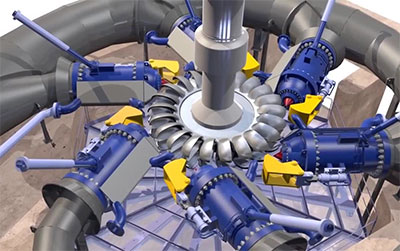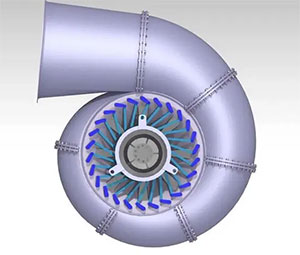Impulse Water Turbine vs. Reaction Water Turbine
The working principle of impulse turbines is the same as that of reaction turbines in that they both use the force and reaction force principle of water flow and runner blades to transmit water flow energy to the runner, causing the runner to rotate and release mechanical energy. The main difference between impulse turbine and reaction turbine lies in the way water enters and exits the turbine, as well as the working principle of the water turbine.
The significant differences between them are:
The Function of the Water Guide Mechanism Is Different
In an impulse turbine, the function of the nozzle (equivalent to the water guide mechanism of the reaction turbine) is to guide the water flow to regulate the flow rate and convert liquid mechanical energy into jet kinetic energy. The guide mechanism of the reaction turbine not only guides the water flow to regulate the flow, but also forms a certain amount of rotating water flow in front of the runner to meet the requirements of different specific speed turbines for the front ring volume of the runner.
Different Changes in Water Flow Pressure
In an impulse turbine, the entire process of water flow from the nozzle outlet to leaving the runner is always carried out in the air, and the water pressure in each part remains unchanged (all equal to atmospheric pressure). Unlike a reaction turbine, the water pressure changes in the guide mechanism, working wheel, and flow channel behind the runner. Therefore, a impulse turbine is also known as a pressureless turbine, while a reaction turbine is called a pressurized turbine.

Differences in Closed Channels
In a reaction turbine, due to the unequal water flow pressure at various locations and not equal to atmospheric pressure. Therefore, enclosed flow channels are required in the water guide mechanism, runner, and the area behind the runner. However, on the impulse turbine, there is no need to set up a closed flow channel.
Different Requirements for Draft Pipes
The reaction turbine must be equipped with a draft tube to restore pressure, reduce kinetic energy loss at the runner outlet, and further utilize the water flow energy between the runner and the downstream water surface. The impulse turbine, on the other hand, has a small flow rate when the water leaves the runner and is usually under atmospheric pressure, so it does not require a draft tube. What’s more, due to the absence of a draft tube, the impulse turbine utilizes less of the water flow energy between the runner and the downstream water surface than the reaction turbine.
Differences in Work Environment
The working wheel of the reaction turbine is submerged in water to work, while the working wheel of the impulse turbine is exposed to the atmosphere, with only a portion of the bucket in contact with the jet for energy exchange. Moreover, to ensure stable operation and high efficiency of the water turbine, the working wheel bucket must have sufficient distance from the downstream water surface (i.e., sufficient drainage height and ventilation height).
Differences in Working Wheel Flow Channels
In an impulse turbine, due to the constant water pressure inside the working wheel, it is possible to widen the flow channel of the working wheel appropriately to make the water flow close to the front of the runner blades, and separate the water flow from the back of the blades by an air layer. In this way, the water flow can not enter the entire circumference of the working wheel, but only enter the working wheel through one or several nozzles in one or several local areas. Due to the fact that the working blade channel is filled with water when facing only one nozzle, and before it moves to the next nozzle, the water in that blade channel has already been emptied, the flow of water along the blade will not be disrupted.
Differences in Applicable Occasions
The working wheels of the impulse turbine only partially pass through the water, while some of the water buckets work. Therefore, the flow rate of the turbine is relatively small. Therefore, under certain water head and working wheel diameter conditions, the output of the impulse turbine is relatively small. In addition, the speed of the impulse turbine is relatively low (this is due to the high absolute speed at the inlet of the runner and the small circumferential speed and output, resulting in a lower specific speed). Therefore, the impulse turbine is suitable for high head and small flow situations.
In summary, the main difference between a reaction turbine and an impulse turbine lies in the treatment method and working principle of the water flow. Reaction turbines utilize the kinetic energy and pressure energy of water flow and are suitable for high flow and low head situations, while impulse turbines transmit kinetic energy through the impact of high-speed water columns and are suitable for high head and small flow situations. The choice of turbine type depends on the characteristics of hydraulic resources, as well as the scale and demand of power plants. Please feel free to contact ATO Store to get more information!


